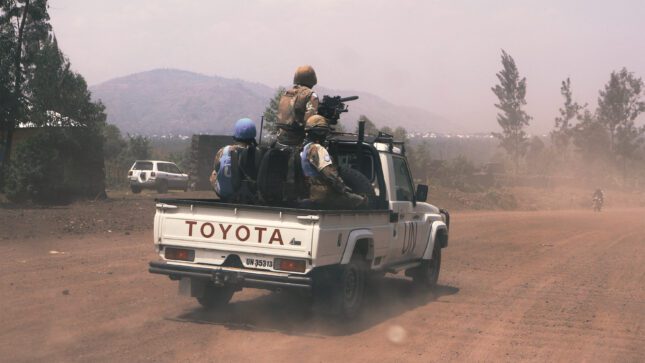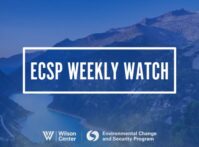-
Going Beyond “Conflict-free”: Transition Minerals Governance in DRC and Rwanda
July 31, 2024 By Neeraja Kulkarni
Resource-rich nations such as the Democratic Republic of Congo (DRC) and Rwanda—which produce minerals ranging from coltan, cobalt, gold, tungsten, and tantalum, to tin (3TG)—hold tremendous importance in the global supply chains. The DRC produces 70% of global cobalt production, while its neighbor, Rwanda, generates around 30% of Tantalum.
Yet as dominating as these numbers may be, mining these critical minerals is plagued with internal and cross-border conflicts, worsening conditions for local communities. Thus, the two countries face significant challenges to govern and satisfy this increasing global appetite for transition minerals.
In critical mineral supply chains, “conflict-free” standards remain central to the peacekeeping efforts of upstream nations, however, integrating them with broader human security and development goals can lead to long-term sustainability. The energy transition must not worsen human conditions and freedoms today in the hope of securing a more sustainable tomorrow.
Conflict is Entangled with Mining
A turbulent relationship exists between the two neighbors, stemming from the 1994 Rwandan Genocide in which Hutu citizens killed more than 800,000 Tutsis in that nation. Subsequent clashes led to the 1996-97 Congo Wars. The conflict in the Ituri and Kivu districts of DRC intensified in 2022, with armed groups taking over regions in the DRC and militaries of both countries having entered each other’s territories. Rwanda’s current role in fueling the conflict in DRC and destabilizing the region by funding armed groups like M23 is a matter of grave concern for securing critical mineral supply chains.
Conflicts in these nations’ mining regions pose a significant challenge to critical mineral supply chains, as armed groups establish extralegal tax regimes that disrupt supply chains and influence global price volatility. Mining-fueled armed groups smuggle minerals into neighboring countries, affecting international markets. The group’s overbearing local presence hampers regulation and transparency efforts, and births plural governance, giving them impunity to a certain extent.
Mining-fueled conflicts also are primary drivers of human insecurity that hamper access to basic amenities such as healthcare, food, and water. Child labor is widespread, with young people blatantly engaged in unsafe mining practices in DRC and Rwanda. Women in Rwanda’s mining sector bear a disproportionate burden of labor within it, and the situation is even worse in the DRC, where they are raped and assaulted in the context of slave labor. Regional conflicts also add to the mix. In 2022-23, Amnesty International reported that Rwanda and Uganda-backed M23 had killed 30 men, and at least 66 women and girls were subjected to rape.
Mining-led environmental damage also has an adverse effect on livelihoods in DRC and Rwanda. In Rwanda, harmful chemicals from tailings seep into the river, harming agricultural practices. Similarly, farmers in the Katangese Copperbelt have complained that mining operations severely affect their physiological health and create river pollution-induced crop loss. The mining sector accounts for 46% of government revenues in DRC, rendering the economy immobile.
Responsible Mining and Transparency Efforts
“Conflict-free” mineral standards, often set up by international bodies, aim to ensure that the sourcing of minerals is responsible and does not contribute to illegal activities or actors. Rwanda focuses on transparency mechanisms to align with responsible mining and due diligence international standards like the US Dodd-Frank Act. Further, in line with the EU-Rwanda supply chain MOU, Rwanda has piloted Certified Trading Chains (CTC) to emphasize artisanal processes in ethical production. It is also a member of the multi-stakeholder tin supply chain initiative (iTSCi) which aims to improve due diligence in mineral traceability among member companies.
Rwanda is taking a step further by prioritizing the formalization of ASM in its efforts. 2014 Mining Code focuses on two crucial aspects of capacity building: the formalization of ASM, and prioritizing regularization of licensing, extraction, and supply chain accountability. In the last decade, Rwanda also deployed a Labor Code to increase the number of miners protected under employment contracts and mitigate child labor. Despite these policymaking efforts, transparency and productivity in the mining sector remain an execution challenge, reflecting the need for financial resources and capacity building, respectively.
Compared to Rwanda, DRC’s governance mechanisms have been limited. The Mining Code of 2018 and then 2022, which remains a central regulatory mechanism, aims to enhance transparency, localize downstream mining industries, and enhance royalties on mining. The nation has also adopted the ICGLR Regional Certification Mechanism (RCM) Manual to promote efficient supply chain management and transparency. However, the regulation and implementation remain weak, with political instability, exacerbating conflicts, and limited resource capacity.
While Rwanda appears to be triumphing in critical minerals governance, it contributes to the conflict in the East of DRC. The legitimacy of Rwanda’s responsible mining and the “conflict-free” minerals tag used by international companies like Apple, has been further disputed as critical minerals are smuggled from DRC by armed groups, and sold in international markets through Rwanda.
As they both aspire toward a common mission of “conflict-free minerals,” it is imperative that they reconvene negotiations and peacebuilding efforts to mitigate the border conflicts that are fueling the violence in mining regions. Rwanda must abide by international law—and ensure it does not contribute to political instability in DRC.
Integrating “Conflict-free” with Human Security and Development
Conflict minerals are attached with ambiguous levels of volatility that influence global markets. This price volatility can be mitigated by peacekeeping efforts in the short term, but by also addressing the socio-political drivers of the conflict in the long-term. As such, international responsible mining standards and programming must expand mandates to support broader human security efforts and development goals in line with existing national development policies.
Developing economies can leapfrog to innovative policies away from traditional industrial policies that often fail to address hyper-complex challenges. Mariana Mazzucato, a renowned economist, suggests the “mission-oriented approach” that calls to gradually reform industrial policies, by increasing the role of the government beyond risk-adjustments. The approach requires teams to cut across ministries with shared missions such as stricter anti-corruption regulations, safeguarding and empowering women, and reintegrating combatants into mining or agriculture activities. These can be implemented with financial support toward broader goals such as peacekeeping and economic diversification with adequate financial support.
The African Union (AU), in line with the African Continental Free Trade Area Agreement (AfCFTA) and Africa Mining Vision, can form funding channels with mineral importing actors to build cross-country processing facilities that distribute the debt burden of foreign investments. These facilities can be integrated with ASM, and further pool scientific expertise (from the continent and the diaspora) to further the national interests of importing nations to diversify supply chains. And to ensure feasibility and viability, the AU can build a sustainable mining framework to ensure that local communities reap the benefits of such developments, than only governments and international actors.
Given their historic presence and influence in the region, international actors must recognize their shared accountability in fueling political instability, human insecurity, and regional tensions. As opaque loans and the corrupt role of multi-national corporations tend to re-establish neocolonial mechanisms, DRC and Rwanda can explore placing “reverse conditionalities” to strengthen ownership and improve programming based on localized data. After all, if the energy transition is a shared vision – the risks and the rewards should be shared too.
Neeraja Kulkarni is a Staff Intern with the Environmental Change and Security Program and a recent graduate from the Fletcher School of Law and Diplomacy, Tufts University. Her interests lie at the intersection of the energy transition and human security in the Global South
Sources: African Society and Conflict, African Union, Al Jazeera, Amnesty International, AP, Bretton Woods Project, FOTRA, Heliyon, Human Rights Watch, ICGLR, IEA, International Mining, ITSCI, IUCN, Journal of African Law, Relief Web, Reuters, SciSpace, University College London, US Department of Labor, USIP, World Peace Foundation
Photo credit: Goma, North Kivu, DR Congo, UN Peacekeepers in back of pick up truck, courtesy of Ellie Matsanova/Shutterstock.com
Topics: Africa, Africa in Transition, African Union, climate, climate change, conflict, decarbonization, democracy and governance, Democratic Republic of Congo, development, energy, environmental justice, gender, geopolitics, human rights, just energy transition, livelihoods, meta, mining, population, Rwanda, security, World Bank
 A Publication of the Stimson Center.
A Publication of the Stimson Center.






